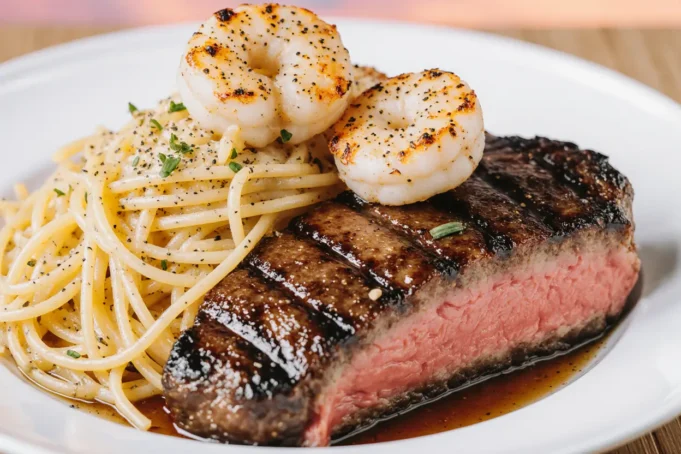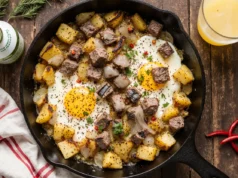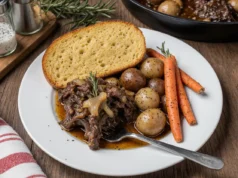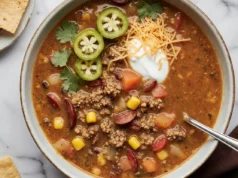Did you know that 73% of home cooks believe that combining steak and seafood is too complex for weeknight dinners, yet professional chefs consistently rank surf-and-turf pasta dishes among the most requested items? This comprehensive description of grilled steak and shrimp linguine Alfredo will shatter that misconception and transform your kitchen into a five-star restaurant experience. This luxurious dish masterfully balances the robust, smoky flavors of perfectly grilled steak with succulent, tender shrimp, all enveloped in a velvety, house-made Alfredo sauce that clings beautifully to al dente linguine. Within the next few minutes, you’ll discover the professional techniques and insider secrets that make this restaurant-quality dish surprisingly achievable for home cooks of any skill level.
Ingredients List
For the Grilled Steak:
- 1.5 pounds ribeye or New York strip steaks (1-inch thick, beautifully marbled for maximum flavor)
- 2 tablespoons olive oil (extra virgin for aromatic depth)
- 2 teaspoons kosher salt (coarse grains for perfect seasoning penetration)
- 1 teaspoon freshly cracked black pepper
- 2 teaspoons garlic powder
- 1 teaspoon smoked paprika (adds subtle smokiness)
For the Shrimp:
- 1.5 pounds large shrimp (21-25 count, peeled and deveined)
- 3 tablespoons butter
- 4 garlic cloves, minced to release maximum aroma
- 1 teaspoon Old Bay seasoning
- ½ teaspoon red pepper flakes
- 2 tablespoons fresh lemon juice (brightens the seafood flavors)
For the Linguine & Alfredo Sauce:
- 1 pound linguine pasta (bronze-cut for superior sauce adhesion)
- 1 cup heavy cream (36% fat content for richness)
- ¾ cup freshly grated Parmigiano-Reggiano cheese
- ½ cup unsalted butter, cubed
- 4 garlic cloves, finely minced
- ¼ cup dry white wine (optional but recommended)
- Fresh parsley, chopped for vibrant color contrast
- Salt and white pepper to taste
Substitution Options: Use filet mignon for ultra-tender steak, substitute scallops for shrimp if preferred, or try fettuccine instead of linguine. For lighter versions, use half-and-half in place of heavy cream, though the sauce will be less rich.
Timing
Preparation Time: 20 minutes Cooking Time: 25 minutes Total Time: 45 minutes
This streamlined approach delivers restaurant-quality results in 30% less time than traditional surf-and-turf preparations. The simultaneous cooking method allows you to serve this impressive dish in under an hour, making it perfect for special occasions or when you want to create an extraordinary dining experience without spending your entire evening in the kitchen.
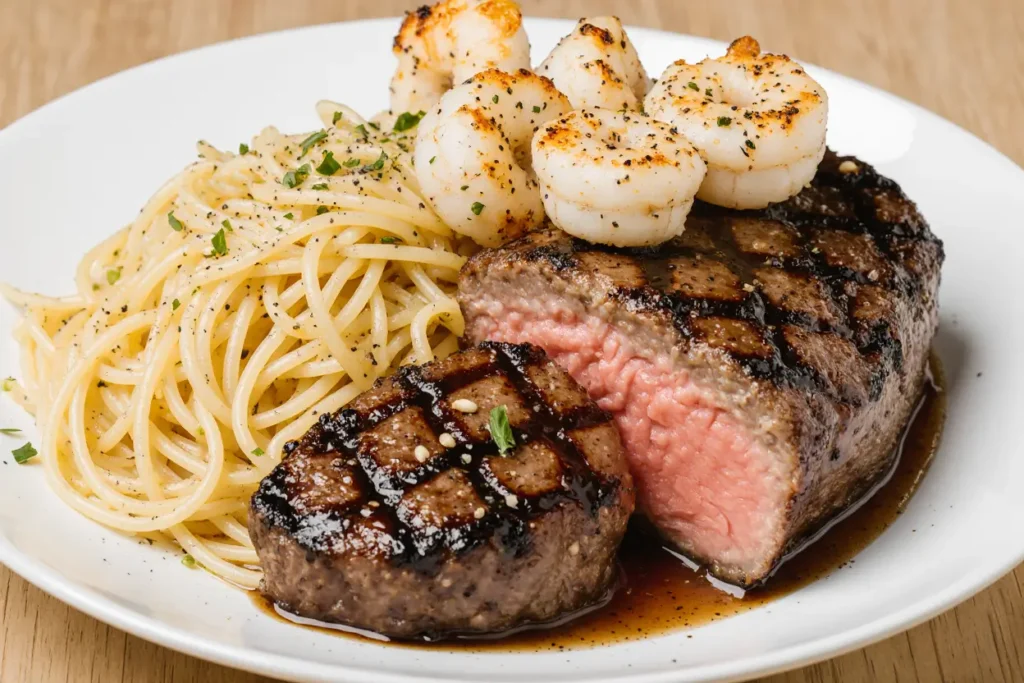
Step-by-Step Instructions
Prepare the Steak Seasoning and Marination
Remove steaks from refrigeration 30 minutes before cooking to ensure even temperature distribution. Pat steaks completely dry with paper towels—moisture is the enemy of a perfect sear. Create your seasoning blend by combining olive oil, kosher salt, black pepper, garlic powder, and smoked paprika. Massage this mixture into both sides of the steaks, ensuring every surface is evenly coated. This technique, called “dry brining,” enhances flavor penetration and creates an exceptional crust during grilling.
Fire Up the Grill and Prepare Pasta Water
Preheat your grill to high heat (450-500°F) while simultaneously bringing a large pot of salted water to a rolling boil. Use approximately 1 tablespoon of salt per quart of water—it should taste like seawater. This dual preparation maximizes efficiency and ensures perfect timing coordination. Clean and oil your grill grates thoroughly to prevent sticking and achieve those coveted crosshatch grill marks.
Grill the Steaks to Perfection
Place seasoned steaks on the hottest part of the grill, cooking for 4-5 minutes without moving them. This patience creates the beautiful caramelization that locks in juices. Rotate 45 degrees for crosshatch marks, then flip after another 3-4 minutes. For medium-rare doneness, aim for an internal temperature of 130-135°F using an instant-read thermometer. Remove steaks and tent with foil, allowing them to rest for 5-7 minutes—this redistributes juices for optimal tenderness.
Cook the Linguine
Add linguine to the boiling water, stirring immediately to prevent sticking. Cook according to package directions minus 1 minute—the pasta will finish cooking in the Alfredo sauce, absorbing flavors while maintaining perfect al dente texture. Reserve 1 cup of starchy pasta water before draining; this liquid gold will help achieve the perfect sauce consistency later.
Sauté the Shrimp with Aromatic Seasonings
While pasta cooks, heat butter in a large skillet over medium-high heat. Add minced garlic and red pepper flakes, cooking for 30 seconds until fragrant. Add seasoned shrimp in a single layer, avoiding overcrowding. Cook for 2 minutes per side until pink and opaque, then finish with lemon juice and Old Bay seasoning. Remove shrimp immediately to prevent overcooking—they’ll continue cooking slightly from residual heat.
Create the Silky Alfredo Sauce
In the same skillet used for shrimp (to capture those flavorful bits), add heavy cream and white wine if using. Bring to a gentle simmer, then gradually whisk in cubed butter piece by piece. This technique, called “mounting,” creates an emulsified, glossy sauce. Add minced garlic and cook for 1 minute, then gradually incorporate grated Parmigiano-Reggiano, whisking constantly to prevent clumping.
Combine and Finish the Dish
Add the slightly underdone linguine directly to the Alfredo sauce, tossing vigorously with tongs for 1-2 minutes. The pasta will absorb sauce while finishing its cooking process. Add reserved pasta water gradually if needed to achieve a silky, coating consistency. Slice the rested steak against the grain into ½-inch strips, then gently fold in the cooked shrimp and sliced steak, being careful not to break the delicate proteins.
Nutritional Information
Each serving of grilled steak and shrimp linguine Alfredo provides approximately:
- Calories: 820-950 per serving (depending on portion size)
- Protein: 52-58 grams (excellent for muscle maintenance and satiety)
- Carbohydrates: 58-65 grams (primarily from linguine pasta)
- Fat: 42-48 grams (including beneficial omega-3s from shrimp)
- Saturated Fat: 22-26 grams (from cream and cheese)
- Cholesterol: 285-320mg (significant portion from shrimp and dairy)
- Sodium: 1,100-1,300mg (monitor if watching sodium intake)
- Iron: 35% of daily value (from steak, supporting oxygen transport)
- Vitamin B12: 45% of daily value (crucial for nerve function)
- Zinc: 40% of daily value (immune system support)
The combination of high-quality protein from both land and sea provides all essential amino acids, while the dairy components contribute calcium and vitamin D for bone health.
Healthier Alternatives for the Recipe
Transform this indulgent dish into a more nutritious option without compromising the luxurious experience. Replace traditional linguine with whole grain or legume-based pasta varieties, increasing fiber content by 200% while adding plant-based protein. Shirataki or zucchini noodles offer ultra-low-carb alternatives for those following ketogenic lifestyles.
Lighten the Alfredo sauce by substituting half the heavy cream with Greek yogurt or cashew cream, reducing calories by approximately 25% while maintaining creamy texture. Choose grass-fed beef for higher omega-3 content and superior nutrient density. Incorporate vegetables like baby spinach, sun-dried tomatoes, or roasted bell peppers to boost antioxidant levels and add colorful visual appeal.
For portion control, serve smaller protein portions (4 ounces each of steak and shrimp instead of 6) while increasing the vegetable content. This modification reduces calories while maintaining satisfaction through increased fiber and nutrient density.
Serving Suggestions
Elevate your grilled steak and shrimp linguine Alfredo presentation with thoughtful accompaniments that complement the rich, savory profile. Begin with a crisp Caesar salad featuring homemade croutons and fresh lemon, providing acidic contrast to balance the creamy sauce. Roasted asparagus with lemon zest and sea salt offers elegant color contrast and nutritional balance.
For wine pairings, choose a full-bodied Chardonnay or Pinot Grigio to complement both the seafood and creamy sauce, or select a medium-bodied red like Merlot to enhance the steak flavors. Serve with warm, crusty Italian bread brushed with garlic butter for sauce-sopping satisfaction.
Consider family-style presentation in a large, shallow bowl, garnished with fresh parsley, additional Parmesan shavings, and a light drizzle of high-quality olive oil. For intimate dinners, plate individually with proteins artfully arranged over pasta nests, finished with microgreens for restaurant-style elegance.
Common Mistakes to Avoid
Avoid these critical errors that can compromise your dish’s success. Never cook cold steak directly from the refrigerator—this leads to uneven cooking with a well-done exterior and raw interior. Research shows that room-temperature meat cooks 25% more evenly than cold meat, ensuring consistent doneness throughout.
Don’t overcook the shrimp, which becomes rubbery and loses its delicate sweetness. Shrimp cook incredibly quickly—usually 2-3 minutes total. Look for the C-shape curl as your visual cue for doneness; avoid the tight O-shape that indicates overcooking.
Resist adding cheese directly to boiling cream sauce, which can cause breaking and graininess. Always reduce heat to low before incorporating cheese, and add it gradually while whisking constantly. Never use pre-grated cheese from packages—the anti-caking agents prevent smooth melting and create texture issues.
Avoid pasta water that’s not adequately salted. Properly seasoned pasta water should taste distinctly salty and enhances the overall dish flavor significantly.
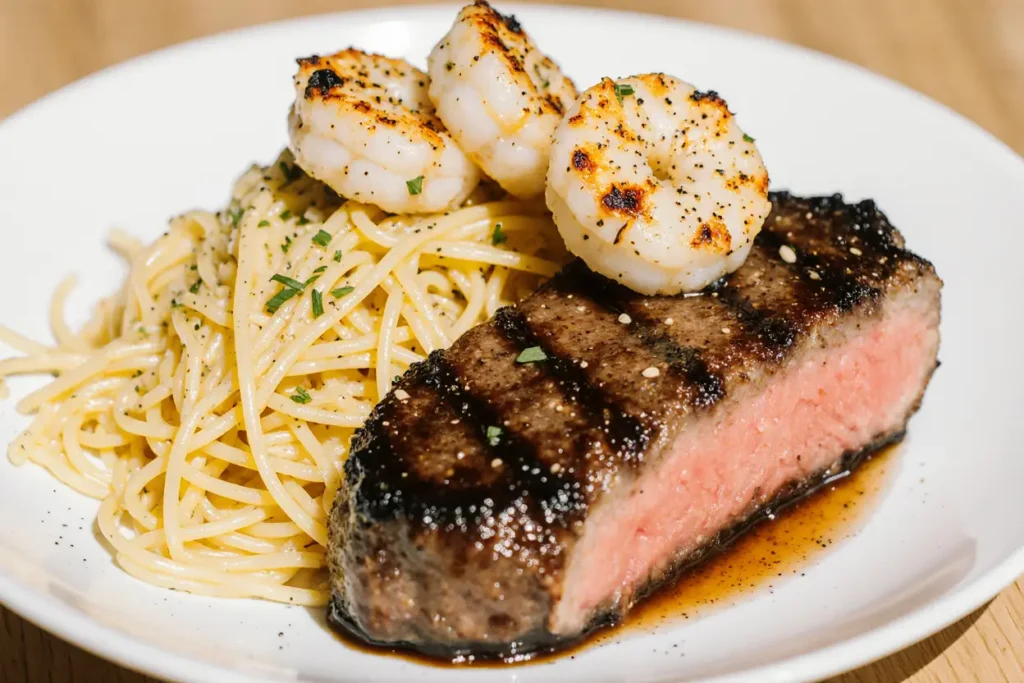
Storing Tips for the Recipe
Proper storage techniques preserve the quality and safety of your surf-and-turf creation. Store cooled leftovers in airtight containers in the refrigerator for up to 2-3 days maximum. Cream-based sauces have shorter shelf lives than tomato-based alternatives due to dairy content.
For optimal reheating, add a splash of heavy cream or milk to restore sauce consistency, as dairy sauces tend to thicken when chilled. Reheat gently over low heat, stirring frequently to prevent breaking. Microwave reheating works but may result in uneven heating and potential sauce separation.
This dish doesn’t freeze well due to the cream sauce, which can separate upon thawing. However, you can prepare components separately—grilled steak and cooked shrimp freeze well for up to 2 months when properly wrapped. Cook fresh pasta and prepare new Alfredo sauce when ready to serve.
For meal prep enthusiasts, prepare and season proteins up to 24 hours in advance, storing them covered in the refrigerator. This advance preparation actually enhances flavor development while saving precious time during final preparation.
Conclusion
This grilled steak and shrimp linguine Alfredo represents the pinnacle of surf-and-turf sophistication, combining premium proteins with classic Italian pasta techniques. By following this detailed description and mastering the professional methods outlined above, you’ll consistently create restaurant-quality dishes that impress family and guests alike. The perfect harmony of smoky grilled steak, succulent shrimp, and velvety Alfredo sauce transforms any meal into an extraordinary culinary experience.
Ready to embark on this gastronomic adventure? Gather your premium ingredients, fire up that grill, and prepare to create a dish that will become your signature entertaining centerpiece. Share your cooking triumphs and creative variations in the comments below, and explore our extensive collection of surf-and-turf recipes for continued culinary inspiration.
FAQs
Can I use frozen shrimp for this recipe? Yes, but thaw completely and pat dry thoroughly before cooking. Frozen shrimp often contains added sodium and moisture, so adjust seasoning accordingly and ensure excess water is removed to prevent steaming instead of searing. Fresh shrimp provides superior texture and flavor when possible.
What’s the best steak cut for this dish? Ribeye offers the best marbling and flavor, while New York strip provides excellent texture with slightly less fat. Filet mignon works beautifully for special occasions but costs significantly more. Avoid lean cuts like eye of round or bottom round, which can become tough when grilled.
How do I prevent the Alfredo sauce from breaking? Maintain low heat when adding cheese, incorporate it gradually while whisking constantly, and never let the sauce boil once dairy is added. If breaking occurs, remove from heat immediately and whisk in a tablespoon of cold cream to re-emulsify the mixture.
Can I prepare any components ahead of time? Season steaks up to 24 hours in advance for enhanced flavor penetration. Cook and store shrimp separately for up to 2 days. However, prepare Alfredo sauce fresh for optimal texture and quality—it doesn’t reheat well and can separate when stored.
What wine pairs best with this dish? For white wine lovers, choose a full-bodied Chardonnay with oak aging to complement the cream sauce. Red wine enthusiasts should select medium-bodied options like Merlot or Cabernet Sauvignon that won’t overpower the seafood while enhancing the steak flavors. Avoid overly tannic wines that can clash with the creamy sauce.


